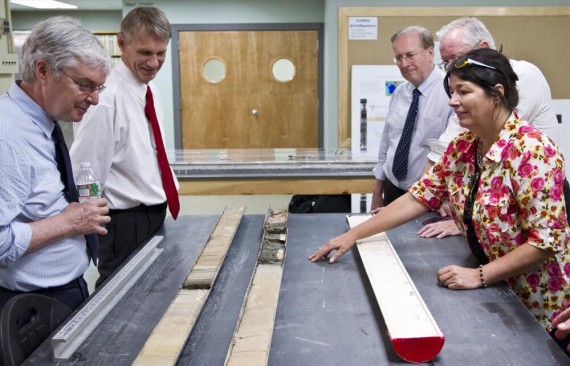A Unique Resource for Understanding Earth’s History and Processes
Lamont’s founder, Maurice “Doc” Ewing, had a vision for studying Earth’s past through sediments on the ocean floor. It came down to four words: “A core a day.” Starting in the late 1940s, wherever a Lamont research ship happened to be, Ewing or his scientists stopped at least once a day to extract a fresh column of mud. Ewing even invented a device, the Ewing Piston Corer, to make the coring work easier.
Due in part to Ewing’s foresight, the Lamont-Doherty Core Repository today houses the world’s largest collection of deep-sea sediment cores—some 19,000 tubes of mud spanning 100 million years. Like pages in a book, the cores provide a record of Earth’s deep past.
The Lamont Core Repository holds one of the world’s most unique and important collections of scientific samples from the deep sea—approximately 72,000 meters of sediment cores from every major ocean and sea.
Bill Ryan, a marine geophysicist, sailed on Lamont’s early research vessels—the Vema and the Conrad–and recalls how smoothly the coring process became. “On the Conrad it was poetry,” he said. In the 1970s, Ryan led a research cruise aboard the Glomar Challenger to the Mediterranean Sea, where he and his colleagues recovered sediments showing that the Mediterranean had once nearly completely dried up. About 6 million years ago, as tectonic forces closed the Strait of Gibraltar, the sea slowly evaporated into a sheet of salt and other minerals.
Sediment cores have yielded other surprises. In a core recovered off Antarctica, Lamont scientist Jim Hays showed that the waxing and waning of Earth’s ice ages was controlled by variations in Earth’s orbit around the Sun and in the tilt and precession of the planet’s spin axis. In a 1976 study in Science, Hays and his colleagues proved to most of the scientific community that Milutin Milankovitch’s theory of climate change due to astronomical forces was correct. After the study’s publication, Hays’ Southern Ocean core became one of the most sought after in the repository. Today, bits of foam plug the holes where sediments have been extracted for analysis.
The Core Repository is an important resource for the international scientific community, which uses the cores for studies of Earth’s climate and past environments. Cores in the collection come from every major ocean and sea, with most having been collected by Lamont’s own research vessels. Under the leadership of geologist and climate scientist Maureen Raymo, this important collection of scientific samples continues to grow, with new material arriving every year from research expeditions around the world.

Core Repository director Maureen Raymo talks with (from left to right) Peter Hildebrand, former astronaut Piers Sellers and Nicholas White, all from the NASA Goddard Space Flight Center, and Lamont’s Sean Solomon about the Repository’s enormous collection of sediment cores and what they reveal about Earth.
In addition to expanding its collection, the Core Repository has also broadened its commitment to geoscience education and outreach. Repository staff and scientists frequently lead tours of the facility and educate teachers, students and the public about the vital role basic scientific research and the Core Repository play in building a better understanding of Earth processes such as climate change, ocean acidification, evolution and tectonics. In 2013, with support from Lamont-Doherty’s Advisory Board Innovation Fund, the Core Repository created a visualization wall, equipped with core description and educational scientific visualizations, to facilitate public education and professional training.
“We have more cores, from more places on Earth, than any other institution,” Raymo said. “They are a treasure trove for understanding how Earth’s climate and life evolved in the past. Humans are currently conducting a giant, unplanned experiment by pumping climate-altering greenhouse gases into the air. The geologic record is the closest thing we have to a control experiment.”